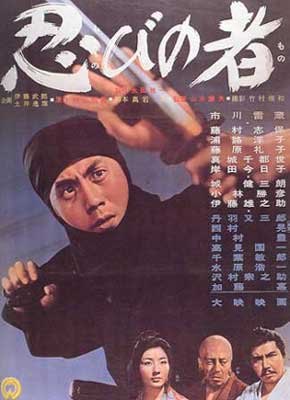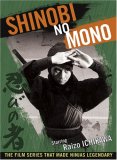| Reviews & Columns |
|
Reviews DVD TV on DVD Blu-ray 4K UHD International DVDs In Theaters Reviews by Studio Video Games Features Collector Series DVDs Easter Egg Database Interviews DVD Talk Radio Feature Articles Columns Anime Talk DVD Savant Horror DVDs The M.O.D. Squad Art House HD Talk Silent DVD
|
DVD Talk Forum |
|
|
| Resources |
|
DVD Price Search Customer Service #'s RCE Info Links |
|
Columns
|
|
|
Shinobi no mono (The Ninjas)
The movie's Japanese title is difficult to translate which may account for AnimEigo's decision, probably a mistake, to retain the Japanese one.* "Shinobi no mono" has been translated as "Those That Are Unseen," but the title more specifically translates to something like "He Who Places His Sword Above His Heart." The movie has been exhibited in the U.S. as Band of Assassins but the film's onscreen subtitles call it The Ninjas.
Shinobi no mono's story is almost absurdly complicated, and AnimEigo's densely translated dialogue and multi-colored annotations arguably make matters worse (more on this below); it's the kind of film best enjoyed for its visual sumptuousness, performances and sweep without trying to follow its intricate plot machinations. Essentially the film, set in 1573, follows promising but ambitious ninja student Goemon Ishikawa (Raizo Ichikawa), who is manipulated by his wily, sinister master, Sandayu (Yunosuke Ito), into attempting the assassination of a sadistic warlord, Nobunaga Oda (Tomisaburo Wakayama, billed here under an earlier stage name, Kenzaburo Jo). He is coerced by Sandayu after Goemon is caught sleeping with his master's love-starved wife, Ino-ne (Kyoko Kishida, in another strong performance) and, later, the life of his reformed prostitute wife, Maki (Shiho Fujimura), is threatened.
The politics and double-crosses of Shinobi no mono, particularly Sandayu's elaborate plotting against Nobunaga, are next to impossible to keep track of, at least on a first viewing, but the film is impressive in other ways. As a ninja action film, the picture offers what was then an impressive array of acrobatics and ninja ingenuity. In one scene tortured ninja agent Yohachi (Yutaka Nakayama) is hog-tied and suspended by Nobunaga's men but escapes by dislocating his wrists and shoulders (which he snaps back into place after freeing himself) but then later, when he's about to be recaptured, cuts off his own face to hide his identity. The film is quite graphic by 1962 Japanese film standards, though comparatively tame today.
Raizo Ichikawa was a kind of Japanese Steve McQueen who, like McQueen, has enjoyed a cult following in the years since his premature death (Ichikawa died of cancer in 1969, when he was just 37 years old). Also like McQueen and in contrast to other Daiei stars like Shintaro Katsu, Ichikawa's passionate fans seem to be composed of as many women as men.
The real star of Shinobi no mono, however, is character star Yunosuke Ito, who deservedly won that year's Blue Ribbon Award in Japan for Best Supporting Actor. The horse-faced actor (Ikiru, Samurai Assassin) was a real chameleon, despite his instantly recognizable, distinctive features, and here gives what may be the performance of his career. As Sandayu he lurks about the rafters of his dojo, spying on his wife and Goemon, sneaks off into the countryside with a ninja's grace (and aided by some rather obvious undercranking) to assume a second identity. His unapologetic ruthlessness contrasted with Ito's trademark stoicness, just barely hinting that he thoroughly enjoys his sadistic power over Goemon, makes him one of the all-time great Japanese movie villains.
Video & Audio
Shinobi no mono is presented in a generally good 16:9 widescreen transfer that retains the original 2.35:1 Daieiscope screen shape. The image is awfully dark at times, but this seems accurate to the original release, and what first seemed like PAL-sourced speed-up appears merely to be director Yamamoto's reliance on undercranking for so much of the ninja footage. The Japanese-only audio is weak, requiring much amplification and it has its share of crackles and pops, though it's acceptable.
The yellow (and, at times, other colors) English subtitles visually are at odds with the black and white cinematography, and so densely-written that at times one scarcely has a chance to look up at the movie; much of the dialogue is a barrage two line-tall subtitles filling the Daieiscope screen end-to-end. The annotations offer a lot of historical minutiae but goes overboard: one bit has Nobunaga halting his horse while saying Doh, which the annotations explain in detail is the Japanese equivalent of "Whoa!" It seems to me that it'd be a lot simpler to just have the subtitles read "Whoa."
Extra Features
Supplements are limited to the usual quirky AnimEigo stuff, which favors yet more historical annotations in the form of text essays over anything like an account of the film's production, detailed biographies of Yamamoto or Ichikawa (capsule bios are included, however) or an attempt to explain its impact on Japanese cinema. Other labels, from Criterion to Synapse, have been doing this for some time now, and the lack of this kind of material (including audio commentaries) really shortchanges customers interested in these films as films, beyond AnimEigo's core audience: fans of violent action films and Japanophiles. An image gallery and a few unrelated trailers are also included.
Parting Thoughts
Shinobi no mono is an entertaining, visually interesting film with several standout performances, particularly from Yunosuke Ito and Kyoko Kishida, though to some degree both Raizo Ichikawa and director Satsuo Yamamoto are working beneath their abilities. The sequels in one sense bear this out: after the first one, the remainder were directed by Daiei house directors, all immensely talented artisans, but to some degree fulfilling studio requirements for a steady stream of escapist entertainments. Nevertheless, it's Recommended.
* I can't imagine walking into a Best Buy, asking some pimple-faced 18-year-old kid if they carry Shinobi no mono and expecting anything other than a look of total confusion. Can you? (Reader Jeff thinks so. He writes, "Hey Stuart, just to let you know, I'm a pimple-faced guy in my early twenties who -- in the past -- worked at a BestBuy. If anyone were to be asking for this particular title, I'd at least have an understanding of what they were referring to, so in the future, try not to judge all of us by our appearance or age.")
Film historian Stuart Galbraith IV's most recent essays appear in Criterion's three-disc Seven Samurai DVD and BCI Eclipse's The Quiet Duel. His audio commentary for Invasion of Astro Monster is now available.
|
| Popular Reviews |
| Sponsored Links |
|
|
| Sponsored Links |
|
|
| Release List | Reviews | Shop | Newsletter | Forum | DVD Giveaways | Blu-Ray | Advertise |
|
Copyright 2024 DVDTalk.com All Rights Reserved. Legal Info, Privacy Policy, Terms of Use,
Manage Preferences,
Your Privacy Choices | |||||||















